Efficient Delivery of CRISPR-Cas9 RNP Complexes with Cyclodextrin-Based Nanosponges for Enhanced Genome Editing: TILD-CRISPR Integration
Abstract
1. Introduction
2. Results
2.1. Preparation and Characterization of RNP/Ppoly Complexes
2.1.1. Fourier Transform Infrared (FTIR) Analysis
2.1.2. Dynamic Light Scattering (DLS) and Zeta Potential Analysis
2.1.3. Qualitative Analysis of Gel Retardation
2.2. 3-(4,5-Dimethylthiazol-2-yl)-2,5-diphenyltetrazolium Bromide (MTT) Assay
2.3. Cellular Uptake and Encapsulation Efficiency of RNP/Ppoly
2.4. 5′/3′ Junction PCR on Stable GFP-Expressing Cell Pool
2.5. Comparative KI Efficiency of Ppolys and Lipofectamine CRISPRMAXTM Delivery Systems
2.6. Out-Out PCR Results
2.7. Insertion Copies Number Analysis
2.8. Junction Validation and Genotyping
2.9. Stability Assessment of GFP-Positive Clones
3. Discussion
4. Materials and Methods
4.1. Synthesis of Ppoly
4.2. DLS and Zeta-Potential Measurement
4.3. FTIR Spectroscopy
4.4. Polymer-sgRNA Complex Formation and Gel Retardation Assay
4.5. Determination of Ppoly/RNP Encapsulation Efficiency
4.6. Cytotoxicity of Ppoly
4.7. Design of sgRNAs and Plasmid Construction
4.8. Plasmid Donor Linearization
4.9. In Vitro Transcription (IVT)
4.10. Cell Culture and Transfection
4.11. Puromycin Selection
4.12. 5′/3′ Junctions and Out-Out PCR
4.13. Limiting Dilution and Single-Cell Cloning
4.14. Evaluation of KI Efficiency
4.15. Copy Number Analysis and Sequencing
4.16. Clonal Stability and Flow Cytometric Analysis
4.17. Statistical Analysis
5. Conclusions
Supplementary Materials
Author Contributions
Funding
Institutional Review Board Statement
Informed Consent Statement
Data Availability Statement
Acknowledgments
Conflicts of Interest
Abbreviations
| CHO | Chinese Hamster Ovary |
| HDR | Homology-directed repair |
| NHEJ | Non-homologous end-joining |
| CD | Cyclodextrin |
| RNP | Ribonucleoprotein |
References
- Amiri, S.; Adibzadeh, S.; Ghanbari, S.; Rahmani, B.; Kheirandish, M.H.; Farokhi-Fard, A.; Dastjerdeh, M.S.; Davami, F. CRISPR-interceded CHO cell line development approaches. Biotechnol. Bioeng. 2023, 120, 865–902. [Google Scholar] [CrossRef]
- Asmamaw, M.; Zawdie, B. Mechanism and Applications of CRISPR/Cas-9-Mediated Genome Editing. Biol. Targets Ther. 2021, 15, 353–361. [Google Scholar] [CrossRef]
- Yang, H.; Ren, S.; Yu, S.; Pan, H.; Li, T.; Ge, S.; Zhang, J.; Xia, N. Methods Favoring Homology-Directed Repair Choice in Response to CRISPR/Cas9 Induced-Double Strand Breaks. Int. J. Mol. Sci. 2020, 21, 6461. [Google Scholar] [CrossRef]
- Huang, Z.; Habib, A.; Zhao, G.; Ding, X. CRISPR-Cas9 Mediated Stable Expression of Exogenous Proteins in the CHO Cell Line through Site-Specific Integration. Int. J. Mol. Sci. 2023, 24, 16767. [Google Scholar] [CrossRef]
- Adibzadeh, S.; Amiri, S.; Barkhordari, F.; Mowla, S.J.; Bayat, H.; Ghanbari, S.; Faghihi, F.; Davami, F. CHO cell engineering via targeted integration of circular miR-21 decoy using CRISPR/RMCE hybrid system. Appl. Microbiol. Biotechnol. 2024, 108, 1–15. [Google Scholar] [CrossRef] [PubMed]
- Hertel, O.; Neuss, A.; Busche, T.; Brandt, D.; Kalinowski, J.; Bahnemann, J.; Noll, T. Enhancing stability of recombinant CHO cells by CRISPR/Cas9-mediated site-specific integration into regions with distinct histone modifications. Front. Bioeng. Biotechnol. 2022, 10, 1010719. [Google Scholar] [CrossRef] [PubMed]
- Devkota, S. The road less traveled: Strategies to enhance the frequency of homology-directed repair (HDR) for increased efficiency of CRISPR/Cas-mediated transgenesis. BMB Rep. 2018, 51, 437–443. [Google Scholar] [CrossRef] [PubMed]
- Lino, C.A.; Harper, J.C.; Carney, J.P.; Timlin, J.A. Delivering CRISPR: A review of the challenges and approaches. Drug Deliv. 2018, 25, 1234–1257. [Google Scholar] [CrossRef]
- Di Stazio, M.; Foschi, N.; Athanasakis, E.; Gasparini, P.; d’Adamo, A.P. Systematic analysis of factors that improve homologous direct repair (HDR) efficiency in CRISPR/Cas9 technique. PloS One 2021, 16. [Google Scholar] [CrossRef]
- Shy, B.R.; Vykunta, V.S.; Ha, A.; Talbot, A.; Roth, T.L.; Nguyen, D.N.; Pfeifer, W.G.; Chen, Y.Y.; Blaeschke, F.; Shifrut, E.; et al. High-yield genome engineering in primary cells using a hybrid ssDNA repair template and small-molecule cocktails. Nat. Biotechnol. 2022, 41, 521–531. [Google Scholar] [CrossRef]
- Yang, H.; Wang, H.; Shivalila, C.S.; Cheng, A.W.; Shi, L.; Jaenisch, R. One-Step Generation of Mice Carrying Reporter and Conditional Alleles by CRISPR/Cas-Mediated Genome Engineering. Cell 2013, 154, 1370–1379. [Google Scholar] [CrossRef]
- Miura, H.; Gurumurthy, C.B.; Sato, T.; Sato, M.; Ohtsuka, M. CRISPR/Cas9-based generation of knockdown mice by intronic insertion of artificial microRNA using longer single-stranded DNA. Sci. Rep. 2015, 5, 12799. [Google Scholar] [CrossRef]
- Yoshimi, K.; Kunihiro, Y.; Kaneko, T.; Nagahora, H.; Voigt, B.; Mashimo, T. ssODN-mediated knock-in with CRISPR-Cas for large genomic regions in zygotes. Nat. Commun. 2016, 7, 10431. [Google Scholar] [CrossRef] [PubMed]
- Quadros, R.M.; Miura, H.; Harms, D.W.; Akatsuka, H.; Sato, T.; Aida, T.; Redder, R.; Richardson, G.P.; Inagaki, Y.; Sakai, D.; et al. Easi-CRISPR: A robust method for one-step generation of mice carrying conditional and insertion alleles using long ssDNA donors and CRISPR ribonucleoproteins. Genome Biol. 2017, 18, 1–15. [Google Scholar] [CrossRef] [PubMed]
- Miyasaka, Y.; Uno, Y.; Yoshimi, K.; Kunihiro, Y.; Yoshimura, T.; Tanaka, T.; Ishikubo, H.; Hiraoka, Y.; Takemoto, N.; Tanaka, T.; et al. CLICK: One-step generation of conditional knockout mice. BMC Genom. 2018, 19, 318. [Google Scholar] [CrossRef]
- Suzuki, K.; Tsunekawa, Y.; Hernandez-Benitez, R.; Wu, J.; Zhu, J.; Kim, E.J.; Hatanaka, F.; Yamamoto, M.; Araoka, T.; Li, Z.; et al. In vivo genome editing via CRISPR/Cas9 mediated homology-independent targeted integration. Nature 2016, 540, 144–149. [Google Scholar] [CrossRef] [PubMed]
- Nakade, S.; Tsubota, T.; Sakane, Y.; Kume, S.; Sakamoto, N.; Obara, M.; Daimon, T.; Sezutsu, H.; Yamamoto, T.; Sakuma, T.; et al. Microhomology-mediated end-joining-dependent integration of donor DNA in cells and animals using TALENs and CRISPR/Cas9. Nat. Commun. 2014, 5, 5560. [Google Scholar] [CrossRef]
- Ghanbari, S.; Bayat, E.; Azizi, M.; Fard-Esfahani, P.; Modarressi, M.H.; Davami, F. Targeted integration in CHO cells using CRIS-PITCh/Bxb1 recombinase–mediated cassette exchange hybrid system. Appl. Microbiol. Biotechnol. 2022, 107, 769–783. [Google Scholar] [CrossRef]
- Rahmani, B.; Kheirandish, M.H.; Ghanbari, S.; Raz, A.; Shamsi, F.; Davami, F. Targeting DNA repair pathways with B02 and Nocodazole small molecules to improve CRIS-PITCh mediated cassette integration in CHO-K1 cells. Sci. Rep. 2023, 13, 1–11. [Google Scholar] [CrossRef]
- Yao, X.; Zhang, M.; Wang, X.; Ying, W.; Hu, X.; Dai, P.; Meng, F.; Shi, L.; Sun, Y.; Yao, N.; et al. Tild-CRISPR Allows for Efficient and Precise Gene Knockin in Mouse and Human Cells. Dev. Cell 2018, 45, 526–536.e5. [Google Scholar] [CrossRef]
- Kheirandish, M.H.; Rahmani, B.; Jaliani, H.Z.; Barkhordari, F.; Mazlomi, M.A.; Davami, F. Efficient site-specific integration in CHO-K1 cells using CRISPR/Cas9-modified donors. Mol. Biol. Rep. 2023, 50, 5889–5899. [Google Scholar] [CrossRef] [PubMed]
- Roth, T.L.; Puig-Saus, C.; Yu, R.; Shifrut, E.; Carnevale, J.; Li, P.J.; Hiatt, J.; Saco, J.; Krystofinski, P.; Li, H.; et al. Reprogramming human T cell function and specificity with non-viral genome targeting. Nature 2018, 559, 405–409. [Google Scholar] [CrossRef]
- Evmenov, K.; Pustogarov, N.; Panteleev, D.; Safin, A.; Alkalaeva, E. An Efficient Expression and Purification Protocol for SpCas9 Nuclease and Evaluation of Different Delivery Methods of Ribonucleoprotein. Int. J. Mol. Sci. 2024, 25, 1622. [Google Scholar] [CrossRef] [PubMed]
- Cheng, Q.; Xia, J.; Wang, K.; Zhang, Y.; Chen, Y.; Zhong, Q.; Wang, X.; Wu, Q. CRISPR/Cas9 ribonucleoprotein (RNP) complex enables higher viability of transfected cells in genome editing of acute myeloid cells. Ann. Transl. Med. 2022, 10, 862. [Google Scholar] [CrossRef] [PubMed]
- Lin, S.-W.; Nguyen, V.Q.; Lin, S. Preparation of Cas9 Ribonucleoproteins for Genome Editing. Bio-Protocol 2022, 12. [Google Scholar] [CrossRef]
- Stahl, E.C.; Sabo, J.K.; Kang, M.H.; Allen, R.; Applegate, E.; Kim, S.E.; Kwon, Y.; Seth, A.; Lemus, N.; Salinas-Rios, V.; et al. Genome editing in the mouse brain with minimally immunogenic Cas9 RNPs. Mol. Ther. 2023, 31, 2422–2438. [Google Scholar] [CrossRef]
- Pi, W.; Feng, G.; Liu, M.; Nie, C.; Chen, C.; Wang, J.; Wang, L.; Wan, P.; Liu, C.; Liu, Y.; et al. Electroporation Delivery of Cas9 sgRNA Ribonucleoprotein-Mediated Genome Editing in Sheep IVF Zygotes. Int. J. Mol. Sci. 2024, 25, 9145. [Google Scholar] [CrossRef]
- Yamagishi, A.; Matsumoto, D.; Kato, Y.; Honda, Y.; Morikawa, M.; Iwata, F.; Kobayashi, T.; Nakamura, C. Direct Delivery of Cas9-sgRNA Ribonucleoproteins into Cells Using a Nanoneedle Array. Appl. Sci. 2019, 9, 965. [Google Scholar] [CrossRef]
- Kuhn, J.; Lin, Y.; Levacic, A.K.; Al Danaf, N.; Peng, L.; Hoehn, M.; Lamb, D.C.; Wagner, E.; Lächelt, U. Delivery of Cas9/sgRNA Ribonucleoprotein Complexes via Hydroxystearyl Oligoamino Amides. Bioconjugate Chem. 2020, 31, 729–742. [Google Scholar] [CrossRef]
- Kim, M.; Hwang, Y.; Lim, S.; Jang, H.-K.; Kim, H.-O. Advances in Nanoparticles as Non-Viral Vectors for Efficient Delivery of CRISPR/Cas9. Pharmaceutics 2024, 16, 1197. [Google Scholar] [CrossRef]
- Wang, C.; Pan, C.; Yong, H.; Wang, F.; Bo, T.; Zhao, Y.; Ma, B.; He, W.; Li, M. Emerging non-viral vectors for gene delivery. J. Nanobiotechnology 2023, 21, 1–18. [Google Scholar] [CrossRef]
- Mahmoudian, M.; Alizadeh, S.; Lotfi, D.; Monfared, Y.K.; Mahdipour, M.; Trotta, F.; Zakeri-Milani, P.; Islambulchilar, Z. Modulating exosomal communication between macrophages and melanoma cancer cells via cyclodextrin-based nanosponges loaded with doxorubicin. Nanotoxicology 2024, 19, 17–27. [Google Scholar] [CrossRef]
- Krabicová, I.; Monfared, Y.K.; Caldera, F.; Mahmoudian, M.; Hobbs, C.; Santalucia, R.; Appleton, S.L.; Matencio, A.; Zakeri-Milani, P.; Trotta, F. Leveraging Cholesterol-Functionalized Cyclodextrin Nanosponges for Enhanced Drug Delivery in Cancer Cells. Int. J. Mol. Sci. 2025, 26, 1213. [Google Scholar] [CrossRef]
- Monfared, Y.K.; Mahmoudian, M.; Cecone, C.; Esfahani, S.; Hayashi, T.; Ishii, K.; Mialni-Zakeri, P.; Matenco., A.; Trotta, F. Inducing anti-tumor immunity in melanoma by delivery of mRNA loaded on a new positive charge hyper-branch cyclodextrin polymer; a novel theranostic approach. J. Nucl. Med. 2023, 64. [Google Scholar]
- Sherje, A.P.; Dravyakar, B.R.; Kadam, D.; Jadhav, M. Cyclodextrin-based nanosponges: A critical review. Carbohydr. Polym. 2017, 173, 37–49. [Google Scholar] [CrossRef]
- Trotta, F.; Dianzani, C.; Caldera, F.; Mognetti, B.; Cavalli, R. The application of nanosponges to cancer drug delivery. Expert Opin. Drug Deliv. 2014, 11, 931–941. [Google Scholar] [CrossRef]
- Trotta, F.; Zanetti, M.; Cavalli, R. Cyclodextrin-based nanosponges as drug carriers. Beilstein J. Org. Chem. 2012, 8, 2091–2099. [Google Scholar] [CrossRef]
- Trotta, F. Cyclodextrin nanosponges and their applications. In Cyclodextrins in Pharmaceutics, Cosmetics, and Biomedicine: Current and Future Industrial Applications; Bilensoy, E., Ed.; Wiley & Sons: Ankara, Turkey, 2011; Chapter 17; pp. 323–342. Available online: https://alraziuni.edu.ye/uploads/pdf/Cyclodextrins-in-Pharmaceutics-Cosmetics_and_Bi.pdf (accessed on 11 September 2025).
- Ma, M.; Li, D. Cyclodextrin polymer separation materials. Patent Application US20010008222A1, 19 July 2001. [Google Scholar]
- Appleton, S.L.; Tannous, M.; Argenziano, M.; Muntoni, E.; Rosa, A.C.; Rossi, D.; Caldera, F.; Scomparin, A.; Trotta, F.; Cavalli, R. Nanosponges as protein delivery systems: Insulin, a case study. Int. J. Pharm. 2020, 590, 119888. [Google Scholar] [CrossRef] [PubMed]
- Danielsen, M.B.; Wengel, J. Cationic oligonucleotide derivatives and conjugates: A favorable approach for enhanced DNA and RNA targeting oligonucleotides. Beilstein J. Org. Chem. 2021, 17, 1828–1848. [Google Scholar] [CrossRef] [PubMed]
- Yao, X.; Wang, X.; Hu, X.; Liu, Z.; Liu, J.; Zhou, H.; Shen, X.; Wei, Y.; Huang, Z.; Ying, W.; et al. Homology-mediated end joining-based targeted integration using CRISPR/Cas9. Cell Res. 2017, 27, 801–814. [Google Scholar] [CrossRef] [PubMed]
- Richardson, R.R.; Steyert, M.; Khim, S.N.; Crutcher, G.W.; Brandenburg, C.; Robertson, C.D.; Romanowski, A.J.; Inen, J.; Altas, B.; Poulopoulos, A. Enhancing Precision and Efficiency of Cas9-Mediated Knockin Through Combinatorial Fusions of DNA Repair Proteins. CRISPR J. 2023, 6, 447–461. [Google Scholar] [CrossRef] [PubMed]
- Richardson, C.; Ray, G.; DeWitt, M.A.; Curie, G.L.; Corn, J.E. Enhancing homology-directed genome editing by catalytically active and inactive CRISPR-Cas9 using asymmetric donor DNA. Nat. Biotechnol. 2016, 34, 339–344. [Google Scholar] [CrossRef]
- Simmons, T.R.; Ellington, A.D.; Contreras, L.M. RNP-based control systems for genetic circuits in synthetic biology beyond 866 CRISPR. In Riboregulator Design and Analysis; Humana: New York, NY, USA, 2022; Volume 2518, pp. 1–31. [Google Scholar]
- Tyumentseva, M.A.; Akimkin, V.G. Protocol for assessment of the efficiency of CRISPR/Cas RNP delivery to different types of target cells. PLOS ONE 2021, 16, e0259812. [Google Scholar] [CrossRef] [PubMed]
- Ray, R.; Ghosh, S.; Jana, N.R. Phosphate-Dependent Colloidal Stability Controls Nonendocytic Cell Delivery of Arginine-Terminated Nanoparticles. J. Phys. Chem. B 2021, 125, 9186–9196. [Google Scholar] [CrossRef] [PubMed]
- Liu, B.; Chan, M.; Chen, H.-H.; Lo, S.; Huang, Y.-W.; Lee, H.-J. Effects of surface charge and particle size of cell-penetrating peptide/nanoparticle complexes on cellular internalization. In Cell Membrane; Nova Science Publishers, Inc.: New York, NY, USA, 2013; pp. 43–57. ISBN 978-1-62808-456-6. [Google Scholar]
- Solmesky, L.J.; Shuman, M.; Goldsmith, M.; Weil, M.; Peer, D. Assessing cellular toxicities in fibroblasts upon exposure to lipid-based nanoparticles: A high content analysis approach. Nanotechnology 2011, 22, 494016. [Google Scholar] [CrossRef]
- Aghamiri, S.; Talaei, S.; Ghavidel, A.A.; Zandsalimi, F.; Masoumi, S.; Hafshejani, N.H.; Jajarmi, V. Nanoparticles-mediated CRISPR/Cas9 delivery: Recent advances in cancer treatment. J. Drug Deliv. Sci. Technol. 2020, 56. [Google Scholar] [CrossRef]
- Monfared, Y.; Cecone, C.; Matencio, A.; Hoti, G.; Kabrikova, I.; Hussein, I.; Desoky, M.; Trotta, F. Application of Cyclodextrin based Polymers for the Gene Delivery. In Proceedings of the 2023 IEEE Nanotechnology Materials and Devices Conference (NMDC), Paestum, Italy, 22–25 October 2023; pp. 484–485. [Google Scholar]
- Pickar-Oliver, A.; Gersbach, C.A. The next generation of CRISPR–Cas technologies and applications. Nat. Rev. Mol. Cell Biol. 2019, 20, 490–507. [Google Scholar] [CrossRef]
- Li, Y.; Gao, J.; Zhang, C.; Cao, Z.; Cheng, D.; Liu, J.; Shuai, X. Stimuli-responsive polymeric nanocarriers for efficient gene delivery. Polym. Gene Deliv. Syst. 2018, 215, 167–882. [Google Scholar] [CrossRef]
- Naeem, M.; Hoque, M.Z.; Ovais, M.; Basheer, C.; Ahmad, I. Stimulus-Responsive Smart Nanoparticles-Based CRISPR-Cas Delivery for Therapeutic Genome Editing. Int. J. Mol. Sci. 2021, 22, 11300. [Google Scholar] [CrossRef]
- Wang, Q.; Chear, S.; Wing, K.; Stellon, D.; Tran, M.T.N.; Talbot, J.; Pébay, A.; Hewitt, A.W.; Cook, A.L. Use of CRISPR/Cas ribonucleoproteins for high throughput gene editing of induced pluripotent stem cells. Methods 2021, 194, 18–29. [Google Scholar] [CrossRef]
- Zhang, L.; Cui, H.; Zhu, M.; Zhao, K. Screening and Analysis of Potential Genes for DNA Damage Repair and Apoptotic Signal in iPSCs Based on CRISPR–Cas9 System. Iran. J. Sci. Technol. Trans. A Sci. 2021, 46, 41–48. [Google Scholar] [CrossRef]
- Sen, T.; Thummer, R.P. CRISPR and iPSCs: Recent Developments and Future Perspectives in Neurodegenerative Disease Modelling, Research, and Therapeutics. Neurotox. Res. 2022, 40, 1597–1623. [Google Scholar] [CrossRef] [PubMed]
- Khan, A.; Sarkar, E. CRISPR/Cas9 encouraged CAR-T cell immunotherapy reporting efficient and safe clinical results towards cancer. Cancer Treat. Res. Commun. 2022, 33, 100641. [Google Scholar] [CrossRef]
- Elmas, E.; Saljoughian, N.; Pereira, M.d.S.F.; Tullius, B.P.; Sorathia, K.; Nakkula, R.J.; Lee, D.A.; Kararoudi, M.N. CRISPR Gene Editing of Human Primary NK and T Cells for Cancer Immunotherapy. Front. Oncol. 2022, 12, 834002. [Google Scholar] [CrossRef]
- Monfared, Y.K.; Mahmoudian, M.; Cecone, C.; Caldera, F.; Haiaty, S.; Heidari, H.R.; Rahbarghazi, R.; Matencio, A.; Zakeri-Milani, P.; Trotta, F. Hyper-Branched Cationic Cyclodextrin Polymers for Improving Plasmid Transfection in 2D and 3D Spheroid Cells. Pharmaceutics 2022, 14, 2690. [Google Scholar] [CrossRef]
- Damavandi, N.; Raigani, M.; Joudaki, A.; Davami, F.; Zeinali, S. Rapid characterization of the CHO platform cell line and identification of pseudo attP sites for PhiC31 integrase. Protein Expr. Purif. 2017, 140, 60–64. [Google Scholar] [CrossRef] [PubMed]
- Haeussler, M.; Schönig, K.; Eckert, H.; Eschstruth, A.; Mianné, J.; Renaud, J.-B.; Schneider-Maunoury, S.; Shkumatava, A.; Teboul, L.; Kent, J.; et al. Evaluation of off-target and on-target scoring algorithms and integration into the guide RNA selection tool CRISPOR. Genome Biol. 2016, 17, 148. [Google Scholar] [CrossRef]
- Pourtabatabaei, S.; Ghanbari, S.; Damavandi, N.; Bayat, E.; Raigani, M.; Zeinali, S.; Davami, F. Targeted integration into pseudo attP sites of CHO cells using CRISPR/Cas9. J. Biotechnol. 2021, 337, 1–7. [Google Scholar] [CrossRef] [PubMed]
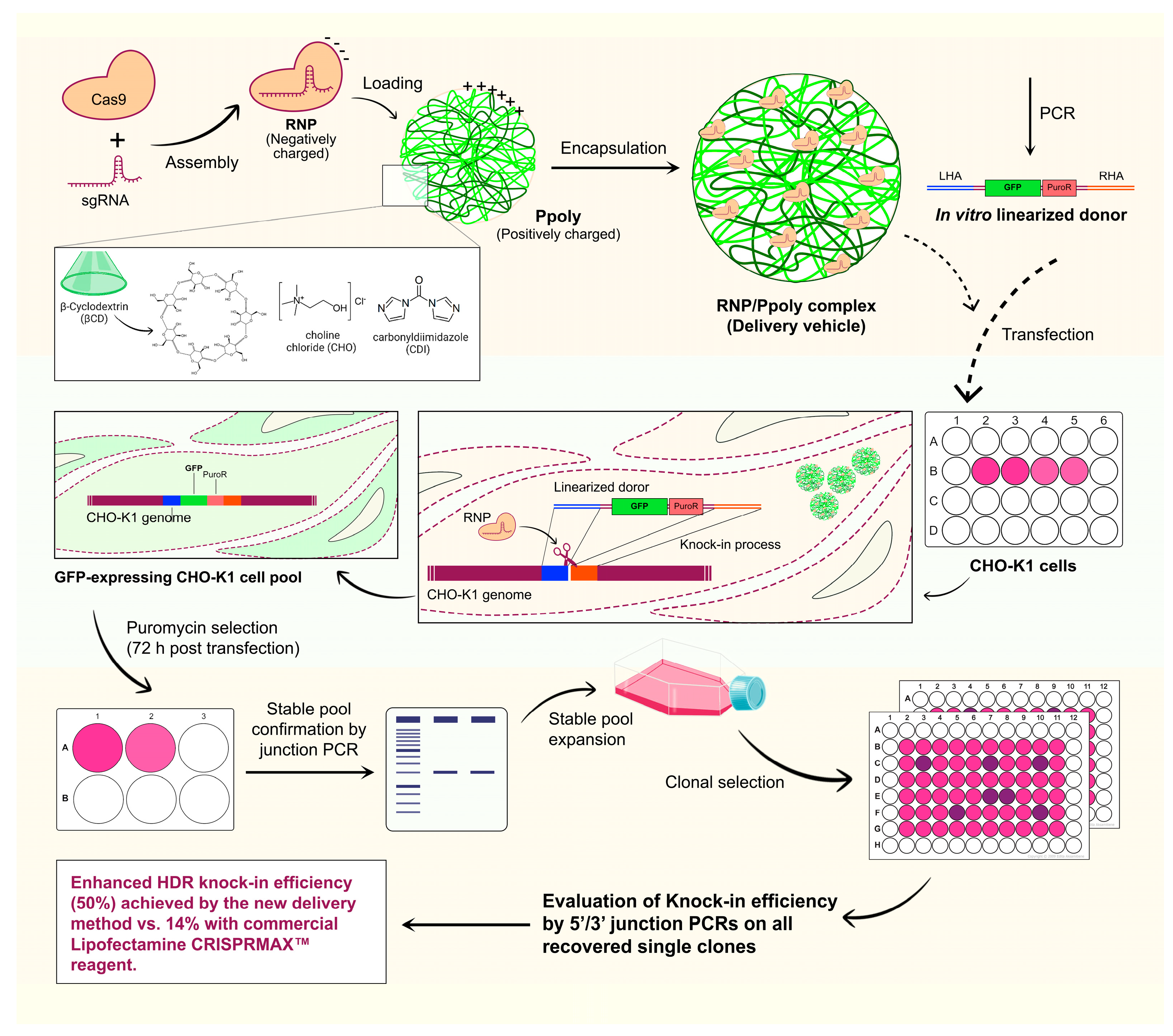

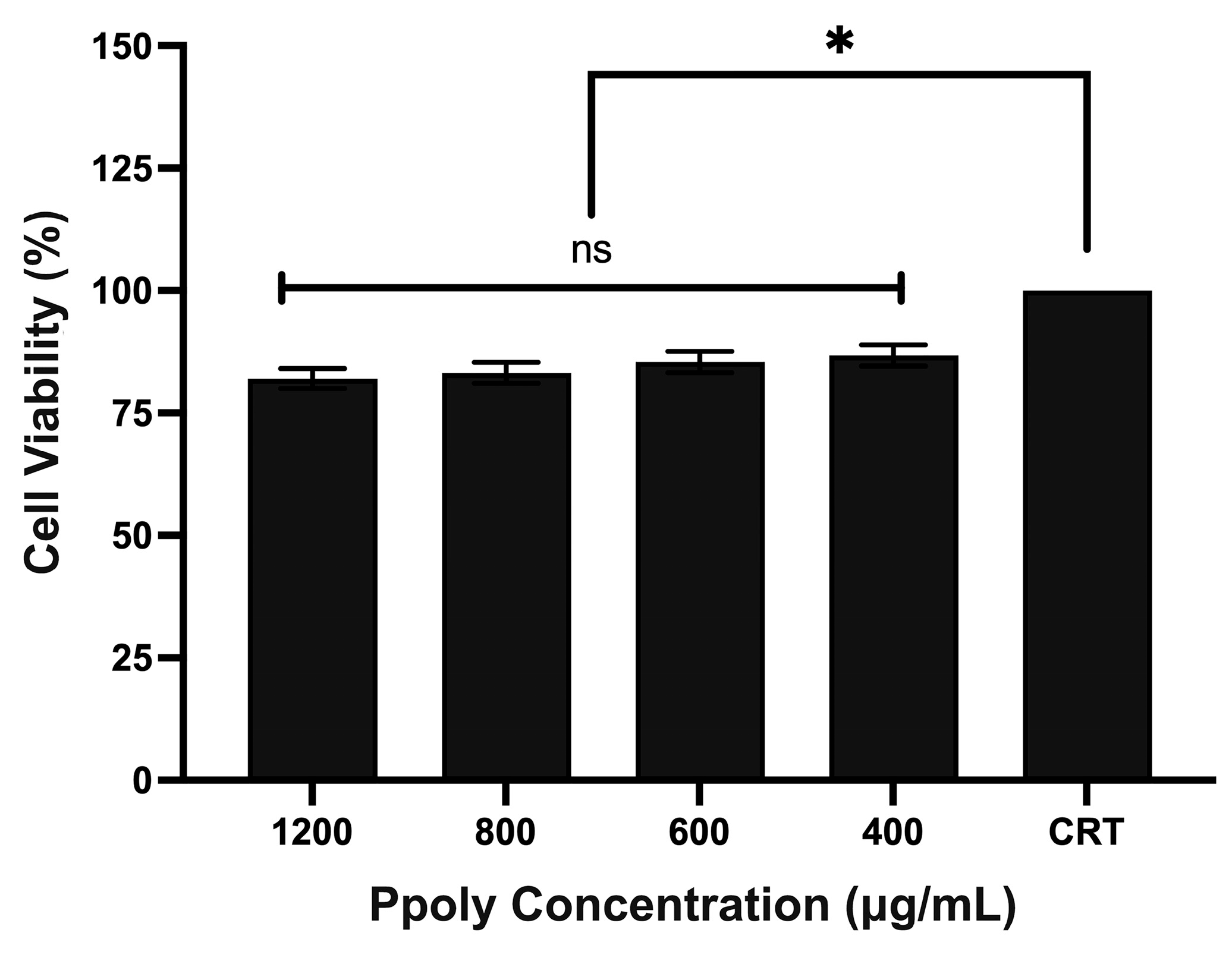
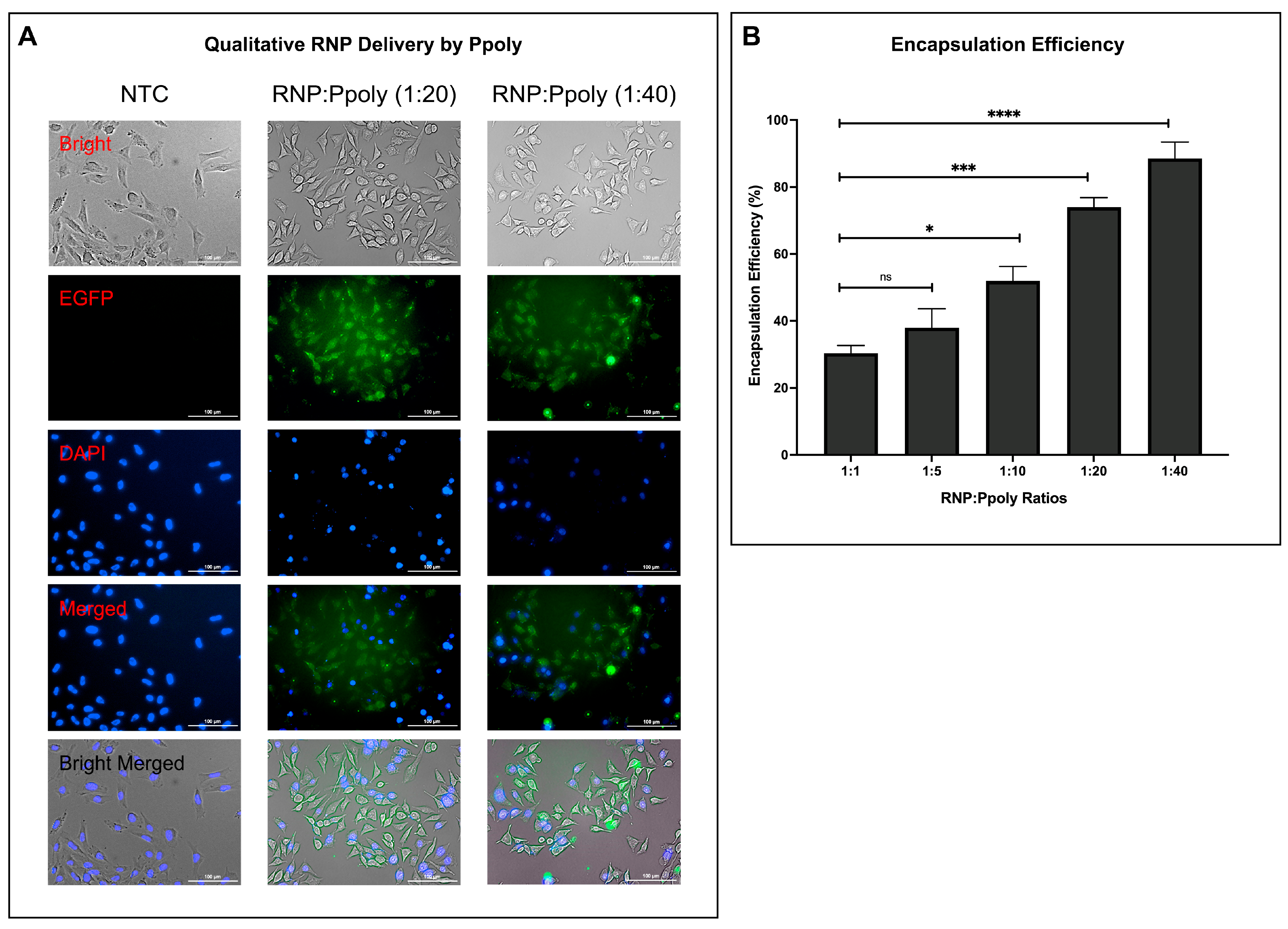

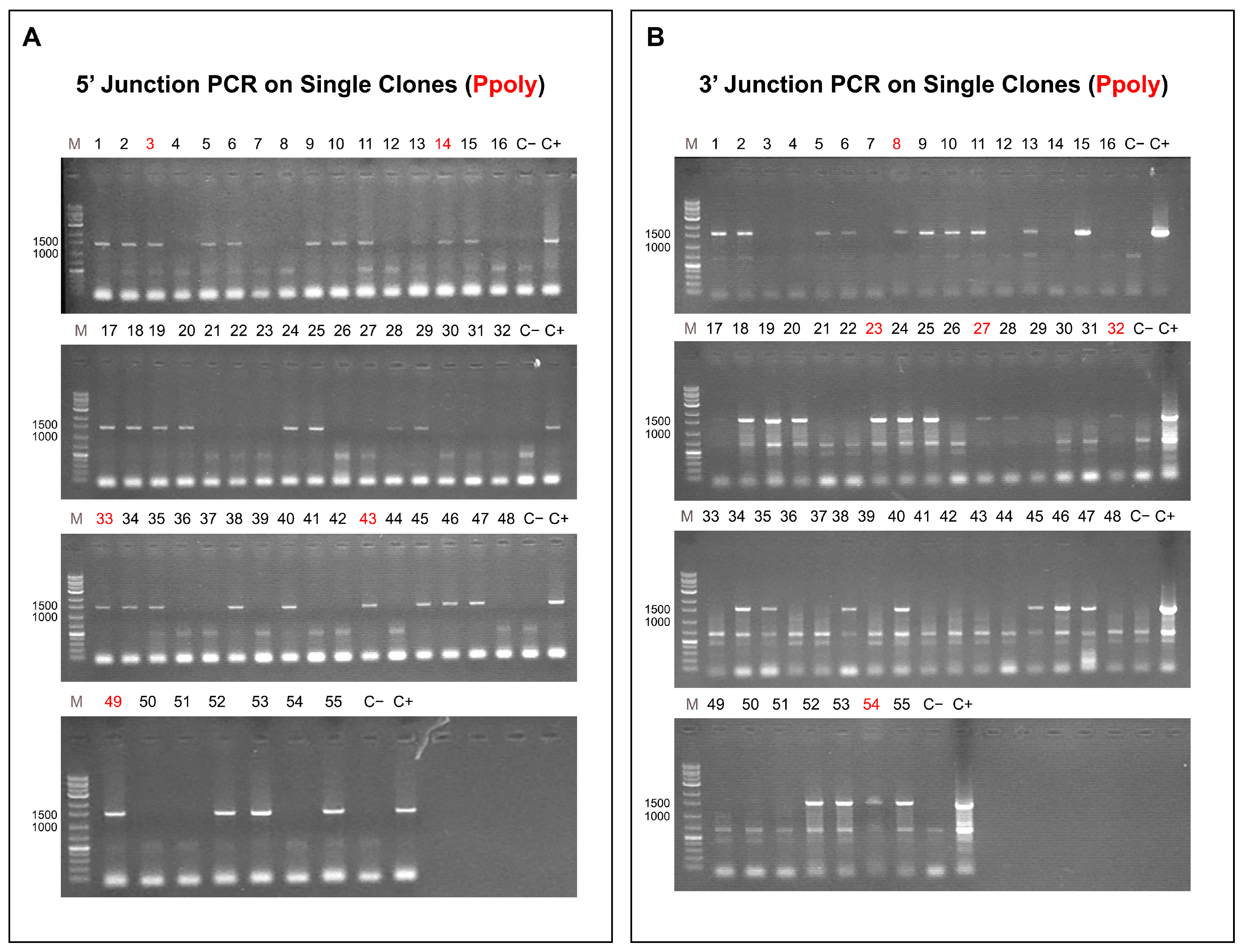

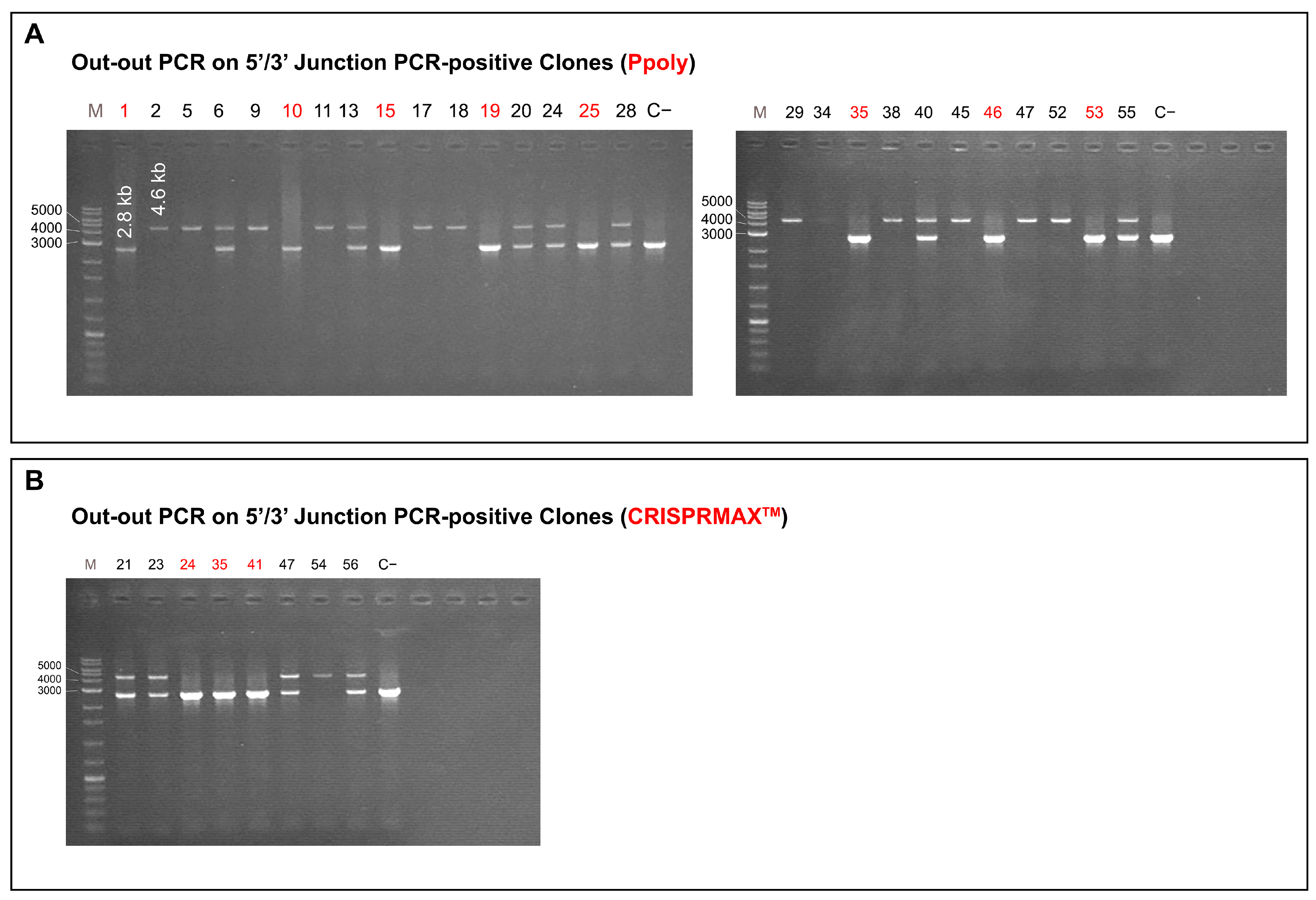

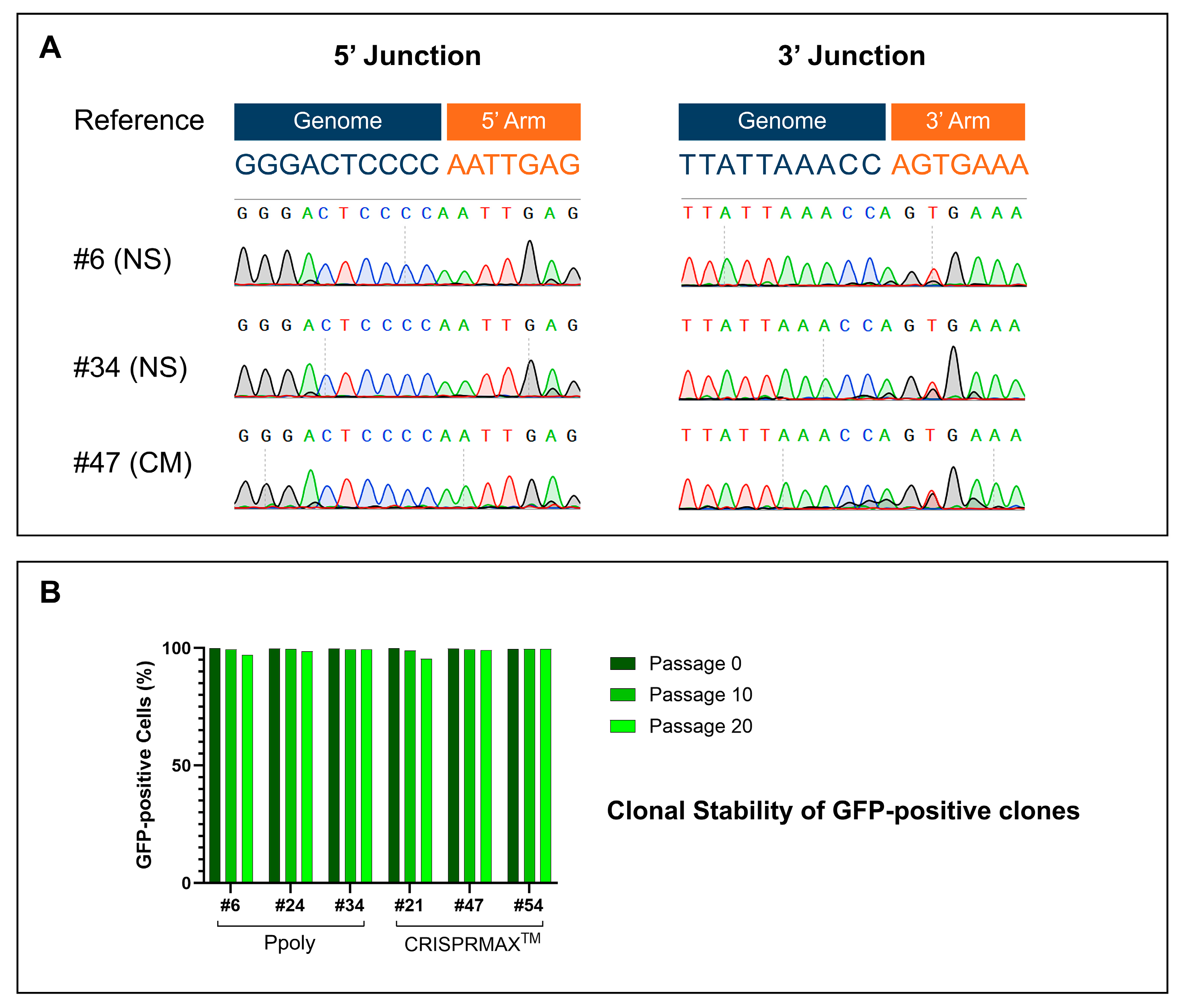
Disclaimer/Publisher’s Note: The statements, opinions and data contained in all publications are solely those of the individual author(s) and contributor(s) and not of MDPI and/or the editor(s). MDPI and/or the editor(s) disclaim responsibility for any injury to people or property resulting from any ideas, methods, instructions or products referred to in the content. |
© 2025 by the authors. Licensee MDPI, Basel, Switzerland. This article is an open access article distributed under the terms and conditions of the Creative Commons Attribution (CC BY) license (https://creativecommons.org/licenses/by/4.0/).
Share and Cite
Amiri, S.; Adibzadeh, S.; Khazaei Monfared, Y.; Kaboli, S.; Arashkia, A.; Barkhordari, F.; Mahmoudian, M.; Kheirandish, M.H.; Trotta, F.; Davami, F. Efficient Delivery of CRISPR-Cas9 RNP Complexes with Cyclodextrin-Based Nanosponges for Enhanced Genome Editing: TILD-CRISPR Integration. Int. J. Mol. Sci. 2025, 26, 10682. https://doi.org/10.3390/ijms262110682
Amiri S, Adibzadeh S, Khazaei Monfared Y, Kaboli S, Arashkia A, Barkhordari F, Mahmoudian M, Kheirandish MH, Trotta F, Davami F. Efficient Delivery of CRISPR-Cas9 RNP Complexes with Cyclodextrin-Based Nanosponges for Enhanced Genome Editing: TILD-CRISPR Integration. International Journal of Molecular Sciences. 2025; 26(21):10682. https://doi.org/10.3390/ijms262110682
Chicago/Turabian StyleAmiri, Shahin, Setare Adibzadeh, Yousef Khazaei Monfared, Saeed Kaboli, Arash Arashkia, Farzaneh Barkhordari, Mohammad Mahmoudian, Mohammad Hassan Kheirandish, Francesco Trotta, and Fatemeh Davami. 2025. "Efficient Delivery of CRISPR-Cas9 RNP Complexes with Cyclodextrin-Based Nanosponges for Enhanced Genome Editing: TILD-CRISPR Integration" International Journal of Molecular Sciences 26, no. 21: 10682. https://doi.org/10.3390/ijms262110682
APA StyleAmiri, S., Adibzadeh, S., Khazaei Monfared, Y., Kaboli, S., Arashkia, A., Barkhordari, F., Mahmoudian, M., Kheirandish, M. H., Trotta, F., & Davami, F. (2025). Efficient Delivery of CRISPR-Cas9 RNP Complexes with Cyclodextrin-Based Nanosponges for Enhanced Genome Editing: TILD-CRISPR Integration. International Journal of Molecular Sciences, 26(21), 10682. https://doi.org/10.3390/ijms262110682






